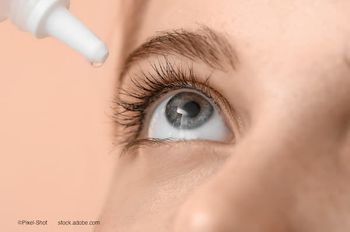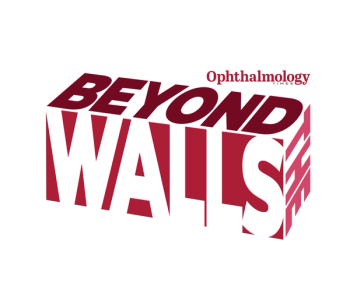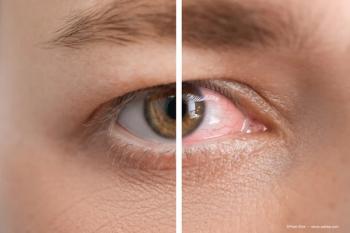
Are you treating conjunctivochalasis effectively for dry eye relief?
Editor’s Note: Welcome to “Eye Catching: Let's Chat,” a blog series featuring contributions from members of the ophthalmic community. These blogs are an opportunity for ophthalmic bloggers to engage with readers with about a topic that is top of mind, whether it is practice management, experiences with patients, the industry, medicine in general, or healthcare reform. The series continues with this blog by Neel R. Desai, MD. The views expressed in these blogs are those of their respective contributors and do not represent the views of Ophthalmology Times or UBM Medica.
Among the mechanical problems related to dry eye is conjunctivochalasis-the Tenon’s capsule condition in which long-term chronic inflammation and dry eye causes dissolution of normal Tenon’s fascia.
The conjunctiva becomes loose (not redundant), shortening the inferior fornix tear reservoir, where half the tear volume resides in healthy eyes. No amount of medication, supplements, or warm compresses will alleviate dry eye in the presence if this mechanical challenge.
I follow a two-pronged approach to the problem.
First, I surgically reconstruct the inferior fornix and tear reservoir.
Second, I start long-term therapy to control inflammation and dry eye disease. The result is relief from dry eye symptoms, including reduced inflammation that prevents conjunctivochalasis from reoccurring.
Diagnosing Conjunctivochalasis
When we see patients who have had dry eye disease for many years, it is wise to consider mechanical deficiencies. They may have the biochemical etiology for dry eye disease, and this mechano-anatomical issue is a long-term consequence.
Diagnosis begins with a detailed history, including symptoms such as epiphora and foreign body sensation that is not relieved by artificial tears because the patient has no natural reservoir to retain them. In the slit lamp exam, I look at tear breakup patterns and staining on the lid margin architecture.
One of the most useful staining techniques for diagnosis is to drop a single drop of fluorescein and look for what I call a “morse code” meniscus because it looks incomplete, like a series of dashes and dots. When I see that, I know the patient has a mechanical problem that will render standard dry eye therapies ineffective.
Some doctors are hesitant to recommend surgery for conjunctivochalasis, but I find it very straightforward and readily accepted by patients with the symptoms of the condition. I explain to patients that the surgery is a minor procedure-a “mini facelift for the eye” that smoothes out wrinkles, removes loose areas, and restores normal anatomy so their eyes will feel better.
I also explain that the procedure works synergistically with patients’ at-home regimen, and I give them my dry eye handbook, which explains the reasons for each diagnostic test, as well as how testing and history tell us which treatment is best to target each patient’s type of dry eye.
Effective Surgical Repair
The only way to treat conjunctivochalasis is to reconstruct the inferior fornix and restore the normal anatomy. Unfortunately, as a result of poor nomenclature, some surgeons choose repair procedures that exacerbate the problem. The term conjunctivochalasis falsely suggests that the patients have excess conjunctiva, so it is pinched and snipped or cauterized, inducing scarring and further contraction of an already foreshortened and poorly defined conjunctiva.
The goal of conjunctovochalasis surgery should instead be to provide for a regenerative and restorative procedure that:
- Replaces the tenons fascia and provides a foundation for smooth, rapid, and healthy conjunctival re-epithelialization,
- Restores the deep and well-defined anatomical definition of the inferior fornix or tear reservoir,
- Prevents inflammation, fibrosis or conjunctival scarring, muscle restriction, and continued orbital fat prolapse, and
- Provides for return to normal tear clearance, complete uninterrupted tear meniscus, patient comfort, and excellent cosmesis.
The active biological growth factors in cryopreserved amniotic membrane can be used to reform or replace diseased Tenon’s capsule. I remove diseased Tenon’s and conjunctiva and prolapsed orbital fat, and then I glue the amniotic membrane, which forms an effective platform for conjunctival growth.
The procedure takes about 10 to 15 minutes and is covered by insurance using codes for ocular surface reconstruction with multilayer graft, and conjunctivoplasty with extensive rearrangement of the conjunctiva and reconstruction of the cul-de-sac.
By smoothing out the conjunctiva and restoring the anatomy of the inferior fornix, we are able to use standard therapies for dry eye with greater beneficial effect, thus addressing both the anatomical and biochemical facets of the patient’s problem.
Follow-up Interventions and Continued Care
By the time patients present with conjunctivochalasis, they have experienced advanced dry eye disease for years. In addition to judging that surgery is the best treatment, I also like that a procedure covered by insurance offers a significant initial step toward healing and symptomatic relief.
Once my patients experience symptomatic improvement after surgery, I perform a combination of intense pulsed light therapy (IPL) (M22 OPT, Lumenis) to reduce inflammatory mediators from capillaries on the eyelids and around the eyes and thermal pulsation therapy (LipiFlow, Johnson & Johnson Vision) to clear the meibomian glands and help them function effectively again.
Thermal pulsation is a single treatment, although patients can be retreated a year later if needed. Patients typically have four IPL sessions two to four weeks apart, with maintenance treatment four to six months later and again after increasingly longer intervals (eventually reaching once per year).
I often prescribe cyclosporine (Restasis, Allergan) or lifitegrast (Xiidra, Shire), and patients continue re-esterified omega-3 fatty acid supplements (HydroEye, ScienceBased Health). I encourage patients to continue using hot compresses as well.
By continuing long-term care and therapy for dry eye, patients not only achieve the symptomatic relief they want, but also, in turn, prevent a return of conjunctivochalasis.
Neel R. Desai, MD, is Director of Cornea, Cataract, and Refractive Services at The Eye Institute of West Florida, Medical Director of the Lions Eye Institute for Transplant Research, and President and CEO of Clarity Visionary Consulting.
Disclosures:
Dr. Desai is a consultant to Allergan, BioTissue, Lumenis, Johnson & Johnson Vision, and Shire.
Newsletter
Don’t miss out—get Ophthalmology Times updates on the latest clinical advancements and expert interviews, straight to your inbox.



















































.png)


